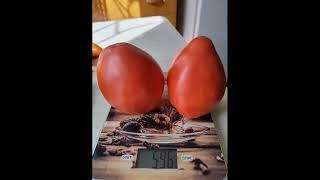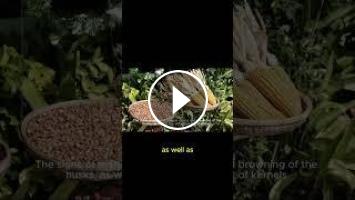#gardening #garden #gardeningtips #howto #how #howtogrowvegetables #environment #offgrid #offgridliving #offgridlifestyle #offgridlife #vegan #vegetables
@palletwoodcamper
Corn, also known as maize, is a versatile crop that can be grown in various regions around the world, provided certain conditions are met. Here's a general overview of how and where you can grow corn:
1. **Climate**: Corn thrives in warm temperatures, typically between 60°F (15°C) and 95°F (35°C). It requires a frost-free growing season of about 60 to 100 days, depending on the variety. The ideal conditions for corn include full sun and well-drained soil.
2. **Soil**: Corn prefers well-drained, fertile soil with a pH level between 5.8 and 7.0. It's important that the soil is rich in organic matter and nutrients, particularly nitrogen, phosphorus, and potassium.
3. **Planting**: Corn is usually planted directly into the ground from seeds. The planting depth should be about 1 to 2 inches (2.5 to 5 cm), and the spacing between rows typically ranges from 24 to 36 inches (61 to 91 cm), depending on the variety and local conditions.
4. **Watering**: Corn requires consistent moisture, especially during the critical growth stages such as germination, tasseling, and silking. Adequate irrigation is essential, particularly during dry periods, to ensure healthy growth and optimal yield.
5. **Fertilization**: Depending on the soil fertility and nutrient levels, additional fertilization may be necessary. Nitrogen is particularly important for corn, and it's often applied in multiple doses throughout the growing season.
6. **Weeding and Pest Control**: Keeping the cornfield free from weeds is essential to prevent competition for nutrients, water, and sunlight. Additionally, corn is susceptible to various pests and diseases, so monitoring and appropriate pest control measures are necessary to protect the crop.
7. **Harvesting**: Corn is typically ready for harvest 60 to 100 days after planting, depending on the variety. The signs of maturity include drying and browning of the husks, as well as the development of kernels. Harvesting can be done by hand or using machinery, depending on the scale of cultivation.
As for where corn can be grown, it's cultivated in many parts of the world, including:
- **North America**: Corn is a major crop in the United States, particularly in the Midwest region known as the "Corn Belt," which includes states like Iowa, Illinois, Indiana, Nebraska, and Minnesota.
- **South America**: Countries like Brazil and Argentina also have significant corn production, often for both domestic consumption and export.
- **Europe**: Corn is grown in various European countries, including France, Ukraine, and Hungary.
- **Asia**: China, India, and Indonesia are among the top corn-producing countries in Asia.
- **Africa**: Corn is a staple food crop in many African countries, with major producers including South Africa, Nigeria, and Ethiopia.
Overall, corn can be grown in a wide range of climates and soil conditions, making it one of the most important cereal crops globally.
Thank you for watching this video.
Please check out our other How To Grow Videos and Garden Projects
@palletwoodcamper
Corn, also known as maize, is a versatile crop that can be grown in various regions around the world, provided certain conditions are met. Here's a general overview of how and where you can grow corn:
1. **Climate**: Corn thrives in warm temperatures, typically between 60°F (15°C) and 95°F (35°C). It requires a frost-free growing season of about 60 to 100 days, depending on the variety. The ideal conditions for corn include full sun and well-drained soil.
2. **Soil**: Corn prefers well-drained, fertile soil with a pH level between 5.8 and 7.0. It's important that the soil is rich in organic matter and nutrients, particularly nitrogen, phosphorus, and potassium.
3. **Planting**: Corn is usually planted directly into the ground from seeds. The planting depth should be about 1 to 2 inches (2.5 to 5 cm), and the spacing between rows typically ranges from 24 to 36 inches (61 to 91 cm), depending on the variety and local conditions.
4. **Watering**: Corn requires consistent moisture, especially during the critical growth stages such as germination, tasseling, and silking. Adequate irrigation is essential, particularly during dry periods, to ensure healthy growth and optimal yield.
5. **Fertilization**: Depending on the soil fertility and nutrient levels, additional fertilization may be necessary. Nitrogen is particularly important for corn, and it's often applied in multiple doses throughout the growing season.
6. **Weeding and Pest Control**: Keeping the cornfield free from weeds is essential to prevent competition for nutrients, water, and sunlight. Additionally, corn is susceptible to various pests and diseases, so monitoring and appropriate pest control measures are necessary to protect the crop.
7. **Harvesting**: Corn is typically ready for harvest 60 to 100 days after planting, depending on the variety. The signs of maturity include drying and browning of the husks, as well as the development of kernels. Harvesting can be done by hand or using machinery, depending on the scale of cultivation.
As for where corn can be grown, it's cultivated in many parts of the world, including:
- **North America**: Corn is a major crop in the United States, particularly in the Midwest region known as the "Corn Belt," which includes states like Iowa, Illinois, Indiana, Nebraska, and Minnesota.
- **South America**: Countries like Brazil and Argentina also have significant corn production, often for both domestic consumption and export.
- **Europe**: Corn is grown in various European countries, including France, Ukraine, and Hungary.
- **Asia**: China, India, and Indonesia are among the top corn-producing countries in Asia.
- **Africa**: Corn is a staple food crop in many African countries, with major producers including South Africa, Nigeria, and Ethiopia.
Overall, corn can be grown in a wide range of climates and soil conditions, making it one of the most important cereal crops globally.
Thank you for watching this video.
Please check out our other How To Grow Videos and Garden Projects
- Категория
- Севооборот
Комментариев нет.




